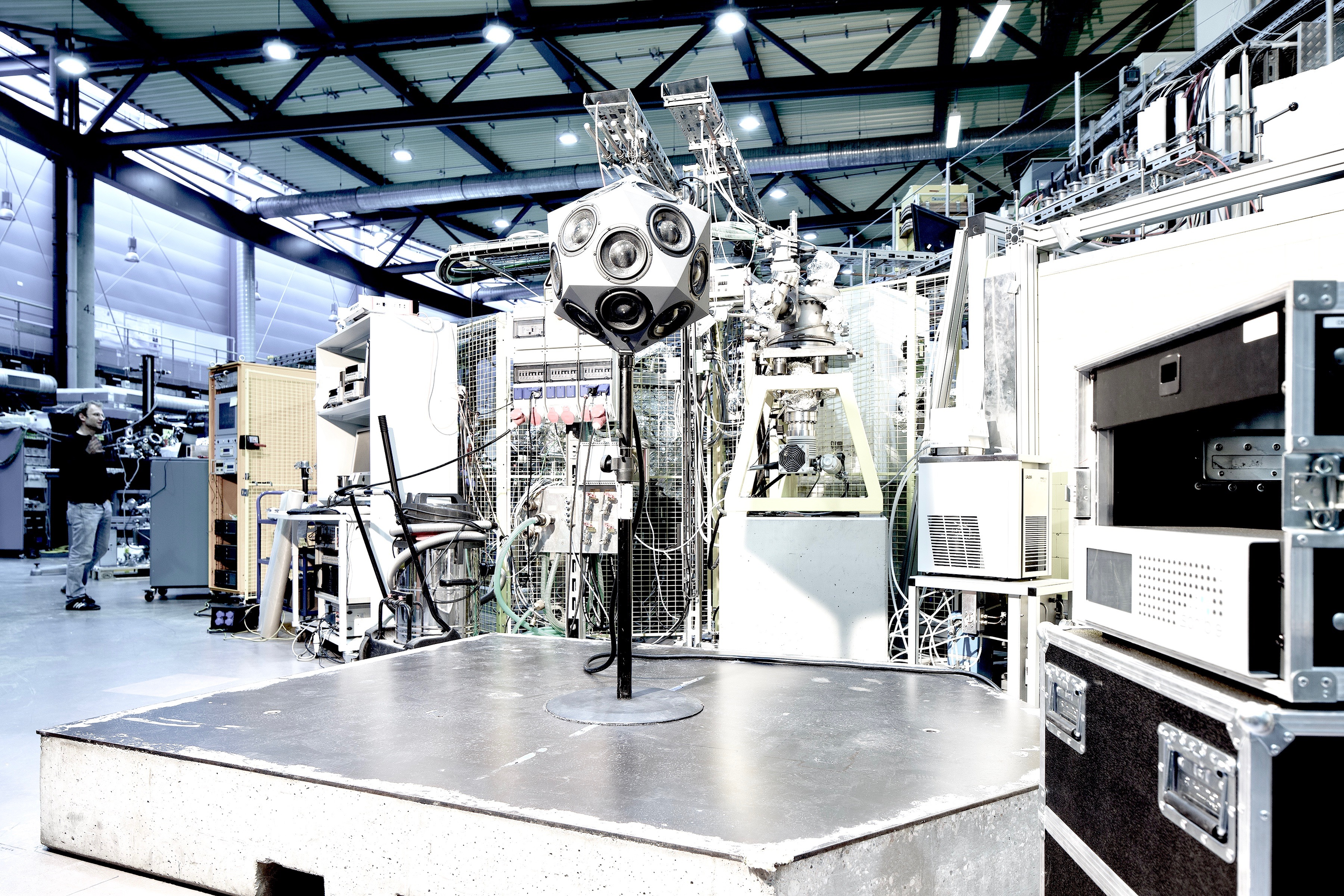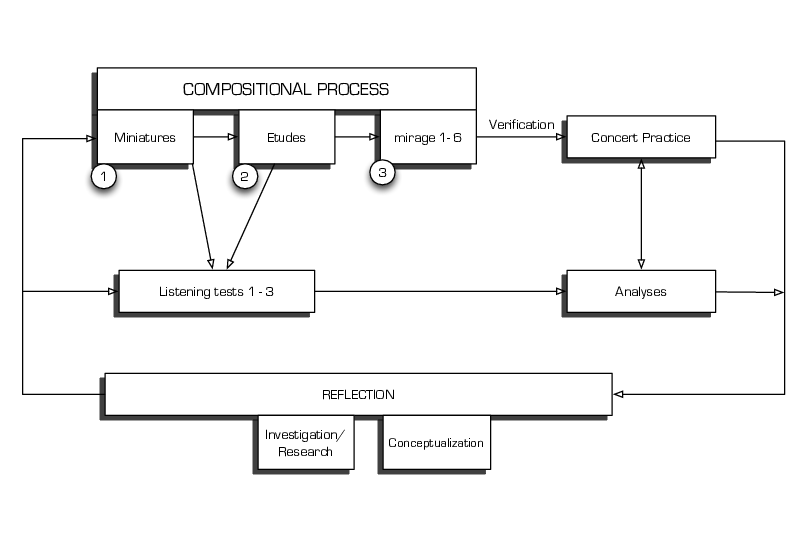AUDITORY OBJECTS are extensively discussed and pursued in the recent artistic research in computer music thus it was not surprising that the IKO was one of various research objects in CoS (Choreography of Sound/PEEK AR 41).
Although CoS considered a more general scope of spatialization systems, the pioneering results of CoS and the above-mentioned compositions grrawe and firniss lay the foundations of OSIL. When beginning to work, it was unclear how to create, shape, and orchestrate auditory objects traversing space by using the IKO. The creation of the targeted auditory impressions could be approached by iterative artistic and scientific work of refining the composition, refining the spatial arrangement, and refining the algorithms of the IKO. Desired auditory objects are only obtained by carefully arranging the product of all of these three factors. In the first pieces, this meant getting to know the instrument’s effect on perception, i.e., its acoustic properties and its potential in each room situation. Nevertheless, a method of how to combine the above-mentioned factors is not yet defined, and clearly lacks research. Many remarkably diverse effects were discovered in the pieces grrawe and firniss by intuition and not any other method or theory.
Psychoacoustically, the auditory effects created by the IKO are not easy to explain. Matthias Frank worked on auditory objects created by amplitude panning on multiple loudspeakers in his PhD thesis [Fra13a]. In particular, for more than three active loudspeakers, their direction of localization, width, and sound coloration were also hard to predict before. His successful methods, listening experiments, and models are a starting point to understanding and discovering the principles behind auditory objects created with the IKO.
*[Fra13a] M. Frank, “Phantom sources using multiple loudspeakers in the horizontal plane,” Ph.D. dissertation, University of Music and Performing Arts, Graz, 2013.
*[DKS93, OR04, RW12] B.-I. Dalenbäck, M. Kleiner, and P. Svensson, “Audibility of changes in geometric shape, source directivity, and absorptive treatment-experiments in auralization,” Journal of the Audio Eng. Soc., vol. 41, pp. 905–913, 1993. // F. Otondo and J. H. Rindel, “The influence of the directivity of musical instruments in a room,” Acta Acustica u. Acustica, vol. 90, pp. 1178–1184, 2004. // L. M. Ronsse and L. M. Wang, “Effects of room size and reverberation, receiver location, and source rotation on acoustical metrix related to source localization,” Acta Acustica u. Acustica, vol. 98, pp. 768–775, 2012.
*[Zot12] F. Zotter, “Holofonie für Musikinstrumente,” in Fortschritte der Akustik - DAGA, 2012.
*[Zot09] F.Zotter, “Analysis and synthesis of sound-radiation with spherical arrays,” Ph.D. dissertation, Univerity of Music and Performing Arts, Graz, 2009.
*[SZre, Ple11, Arr12] G. K. Sharma and F. Zotter, grrawe - For a couple of years only one inhabitant resided there, and also he was only rarely at home, 2009 (premiere). // P. Plessas, “Die ganze welt im rückspiegel,” in performed at: ICMC, Ljubljana, 2012; next generation Festival at the Centre for Art and Media Technology ZKM Karlsruhe, 2011; ICSA Int. Conf., Detmold, 2011, 2011. // R. G. Arroyo, “Day&night, syking, and topoi,” in On the Choreography of Sound, PEEK Concert, 2012.
*[Har83] W. M. Hartmann, “Localization of sound in rooms,” JASA, vol. 74, pp. 1380–1391, 1983.
These AUDITORY OBJECTS leave us with a universe of questions
Can the electroacoustic auditory objects of the IKO be reproduced in a composition? Which parts of these auditory objects only develop in the (acoustic) imagination of the composer, and which are transparent to the audience – are they to be seen more as metaphorical and programmatic settings that serve the composer primarily as aids in dealing with the technical equipment? How can one stage the auditory objects and make them tangible for an audience? What spatial conditions are required to do so? How can one describe and verbalize these objects for intra- and interdisciplinary exchange? In the case of many musical effects that emerge and which are being reinforced by the IKO, the question remains: why and how?
Pierre Boulez’ remark Le haut-parleur anonymise la source réelle inspired research in musical acoustics and electroacoustics [Wei04] by stating that loudspeakers alienate natural sources by modifying how their sound is radiated into the room. There is plenty of evidence on how the radiation characteristics influence sound in rooms [DKS93, OR04, RW12], and it is most plausible when motion of the musician is involved. Equipped with background knowledge about sound radiation [Zot12], the powerful prototype of the IEM IKO [Zot09], expertise in psychoacoustic evaluation and modeling of spatial sound [Fra13a], and pioneering experience in music written for the IKO as a new musical instrument [SZre, Ple11, Arr12], we postulate a slight variation of the above as the artistic research hypothesis of OSIL: Loudspeakers of adjustable radiation naturalize alien sounds by embedding them in the natural spatiality of the room, cf. also conclusion 2 in [Har83].
An ITERATIVE PROCESS was followed as part of the work,
consisting of text retrieval, composition, terminology research (verbalization), listening experiments and psychoacoustic modeling. This process was repeated several times, meaning information gained from the evaluations informed the further working and compositional process.
The SCHEME shows the iterative research process,
here always starting from the field composition in threefold repetition. Based on very simple composed spatial-sound constellations (1. miniatures), first self-tests, later with test persons in the laboratory, then followed by listening tests, the results of which flow directly into the performance and concert practice with the IKO.
AT THE SAME TIME,
these are evaluated in terms of engineering, in order to arrive at technical explanations of the phenomena occurring in the form of psychoacoustic models, which are then discussed, published and applied in the further working process. The reflection on the possibilities of verbalization of the phenomena, the experiences from the performances, the modeling and results of the self-experiments in exchange with the audience, colleagues and supervisors then flow into the composition of complex spatial-sound definitions (2. etudes). These then go through the process described above and eventually lead to the composition of independent compositions - mirage 1-6 -, which in turn are described and interpreted with the terms established in the working process in order to prove the coherence of the artistic research results.
The Virtual IKO (ViKO)
We also saw the demand for technology to give composers a feeling of the venue acoustics while working in the studio. [Peters et al., 2011, 25]
Due to my concert practice with the IKO as well as other loudspeaker systems, the desire arose for a spatial simulation of the corresponding performance rooms developed in order to be able to carry out concert preparations on the spot in the absence of sufficient rehearsal time. But a kind of spatial sketch book was also necessary for the continuous compositional process with sculptural sound phenomena in order to, on the one hand, not become dependent on permanent access to loudspeaker technology and, on the other hand, to confine the process to the studio.
The virtual IKO (ViKO) was developed as part of OSIL's research in 2016 [Zaunschirm et al., 2016].
This is a plug-in for a binaural headphone environment that can simulate the IKO with its spatialization effects in various spatial situations, e.g. room size, reflective properties, and various listener positions. The ViKO is generated on the basis of recordings of space impulse responses, successively stimulated by the IKO's 20 loudspeakers with 32 channels of the EM32 at the desired listening positions and the IKO's position. The listening examples included in the work are, correspondingly, all binaural with the ViKO, rendered from two listening positions. In addition, a simulation for IKO compositions was developed, which allows these compositions to be performed without the IKO, or at least spatializations with the IKO-typical spatial effects, e.g. in a standardized 8-channel ring.
FIRST PRACTICAL STEPS focused on the compositional reduction of plastic sound formations as miniatures, with a length of ca. 30 seconds each.
The speaker was positioned in the same room the same way always.
The resulting 64 space-sound miniatures were first described by Gerriet K. Sharma from two listening positions using the following categories:
- Used Sound Material
- Patterns of Movement
- Speed
- Produced Perceivable Form In Space
After revisiting FURTHER STAGES in the process, the newfound concepts contour, directionality, and plasticity were added to the description log.
These miniatures then formed the basis for the selection of the first stimuli for listening experiments 1 and 2.
The RESULTS OF LISTENING EXPERIMENTS 1 and 2 were compared with Sharma's own experience and fed into the compositional process of more complex space-sound sculptures I refer to as etudes.
Sharma then CLASSIFIED THE ETUDES in special respect to their body-space relation (kernel plastic, spatial plastic, kernel-shell principle.)
These STUDIES were then examined in two other listening experiments and subsequently make up solid components of independent compositions, together forming the series of works mirage 1 - 6.
The RESULTUNG COMPOSITIONS, created over a period of three years, include many of the spatialization models proven by the miniatures and etudes, or have both combined and further developed them.
In this case, only the SCULPTURAL BODY-SPACE MODELS were implemented and used as general molding principles. The six finished works were then again subjected to analysis with the aid of the extended terms from the scholastic writings on sculpture.
SCIENTIFIC ANALYSIS
The experimental design and the implementation of listening experiments 1-3, as well as their evaluations, were carried out by and in cooperation with engineers Franz Zotter, Matthias Frank, Florian Wendt and Markus Zaunschirm.
The respective analyses have been published and in turn included in the artistic work process. The changing artistic and practical requirements of the IKO have also been adopted and implemented in detail by means of the growth of knowledge derived from engineering studies, such as filter improvement, software extensions, simulation and performance stability.
At all stages of the iterative process, the historical and musicological analyses have been a part of the conceptual and practical developments in relation to the formulation of conditions for the composition of sculptural sound phenomena in computer music.

